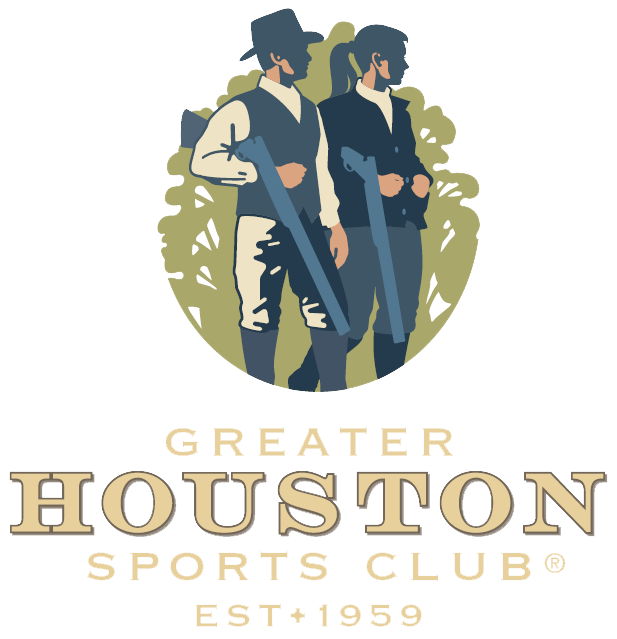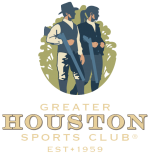2017 NSSA/NSCA All Around Club of the Year
2017 Texas Club of the Year by TSCA Membership
2014 NSSA/NSCA All around club of the year
2012 Texas Club of the Year by TSCA Membership
2003 NSSA/NSCA All around club of the year
2001 NSSA President’s Award
2000 NSSA President’s Award
1999 NSSA Club of the Year
"Love the excitement this place offers and yet very close to th center of town."
"The best place to have a sporting clays event. Ashley and the rest of the staff are excellent and they have the best facilities in the city."
"Hands down THE best clays rangeclub in Houston! Kevin (GM) and his staff are top shelf! Great place to hold events."
Exploring Our Roots
By: R.K. Sawyer
We’re over a half-century-old now. We know we are, have an idea where we are going, but how many of us know where GHSC has been?
The roots of competitive sport shooting go back to just after the Civil War, a time when shotguns were most often in the hands of men who used them to eat. But economic growth after the war allowed for some outdoorsmen both the means and leisure time to begin using guns for sport. These men were most often the movers and shakers of Texas business and politics, and most lived in bustling San Antonio, Dallas, Waco, Galveston, or Houston. It was these urban sportsmen who, around 1870, founded Texas’ first competitive shooting clubs.
Members of these early clubs, along with their friends and families, often filled private Pullman rail cars and crisscrossed the state to compete in organized shooting matches. In the days before clay targets, they used glass balls, live pigeons, or sponsored “prize hunts,” where teams competed to kill the largest number of wild game on the wing. Winning “prize hunt” teams totaled the highest score from different point values assigned to waterfowl, shore- and wading birds, prairie chickens, doves, quail, hawks, eagles, and owls. With the reputation of their clubs and home cities at stake, wagers on the outcome of any sporting event varied from as little as an oyster and champagne dinner to thousands of dollars.
Houston Gun Club, Houston’s first organized shooting venue, was founded in the 1870s on an 8,000-acre “game preserve” beside Buffalo Bayou. Houston Gun Club at the turn of the century boasted 50 members and a “finely appointed clubhouse” that overlooked an artificial lake. At some point after the 1920s, the club grounds were relocated near what is now the corner of I-610 and Westheimer Avenue. The late Liston Roberts, a long-time GHSC member, recalled that Houston’s growth forced the club to relocate in the 1950s. He said the birth of GHSC, in at least one version of its founding, was a result of sporting enthusiasts who saw an opportunity in venerable Houston Gun Club’s adversity.
It is hard today to visualize what the GHSC landscape looked like at the turn of the 19th century. The south bank of Simms Bayou was far from the heart of Houston; it took half a day on horseback to reach the location as swarms of mosquitoes rose in clouds from stirrup-high prairie grass. The soil was rich, but too wet for agriculture until the late 1910s when the area was drained and native prairie burned. Together man and beast turned the scorched earth into a network of irrigation canals to grow thousands of acres of rice. Some of the old rice levees can still be seen today south of the clubhouse.
Though no one suspected it at the time, the future of that rice field south of Houston would be linked with Forest McNeir. Born in 1875, McNeir was raised in the hardscrabble fishing and farming community of Smith Point, Chambers County. He made money as a boy collecting and selling turtles, eggs from birds and alligators, and hauling farm products to Galveston by sailing sloop. Later he worked as a market hunter, shooting and selling canvasbacks for Colonel Moody at Lake Surprise, deep in the Chambers County marshes. McNeir went on to become one of the best shots in the United States. As an adult he worked as a general contractor, his path crossing GHSC in 1957 when, in the months just before he died, he drew up the plans for our clubhouse, outbuildings, and shooting fields. His photograph today hangs prominently in the clubhouse.
The visionaries behind GHSC were founding directors and officers James C. Roberts (President, 1958), John R. Downes (Chairman of the Board, 1958), Gordon Nees, H.J. Yoakum, L. E. Minor, Edmund L. Buckley (President, 1960), Titus Harris Jr. (President, 1961), and Ralph W. McNeir. Frank Moreno, from the South Louisiana Gun Club, was hired as the first club manager. The board initially advertised for members, instructing interested parties to contact E.L. Buckley at the Southwest Bank Building in Houston or, in the days before emails and area codes, to call him at CA (for capitol)-4-2915 for more information. The strategy worked; shares of stock were sold to 100 original members, their dues set at $10 a month. The roster who proudly wore the first GHGC membership lapel pin was a who’s who of 1950s Houston, including George R. Brown, Harry, and Roy Cullen, oilman Michael Halbouty, Grant Ilseng of Texas Sporting Goods, and Jake Oshman, to name but a few. Keenly aware of the value of local press, honorary memberships were provided to another half dozen Houston area newspapermen.
GHSC founders selected the site for the club in a 130-acre rice field well outside of the Houston city limits. The dream became reality when the Board of Directors, along with some supportive founding members, each guaranteed $2,000 on a $30,000 bank loan. Forest McNeir & Son Contractors was selected to build the facility, with Ralph McNeir completing construction after his father’s passing.
Construction began on July 4, 1958. Delays plagued the work from the very beginning – it took a month just to build the access road, and flooding rains limited construction to only two days during the entire month of September. When the club officially opened in December with two skeet and two trap fields, the clubhouse was still unfinished.
Despite the challenges, GHSC opened its doors with a bang. The public was invited to a weekend of festivities that included exhibitions by Winchester “Showman Shooter” Herb Parsons, and drew a crowd estimated with as many as 5,000 spectators. The event was covered by some of Texas’ most renowned outdoor writers of the time, including GHSC honorary members Harv Boughton of the Houston Post and the Houston Chronicle’s Bob Brister.
The club grew quickly in its first year. Additional skeet and trap fields were built. Clay targets were joined by live bird shooting – called “Flyer (pigeon) Shooting” – when several of the founding officers and members, who titled themselves the “Flyers Syndicate,” donated the funds to build a pigeon ring, traps, “electrical controls,” and a bird loft. By spring of 1959, the Houston press was abuzz with the club’s new $100,000, “ultramodern” clubhouse, its “cocktail and dining lounges,” a ladies' card room and, most importantly, air-conditioning. The interior décor was touted as “Early American,” designed by Mrs. J.C. Roberts, wife of GHSC's first club president. The clubhouse is what separated the members from non-members; according to Kay Hawthorn, daughter of Mr. and Mrs. James Roberts, GHSC in its early years was open to the general public. The shooting public was not allowed access to the main building but could use outside restrooms. Both non-members and members lined up to purchase tokens for skeet and trap or shotgun shells from what, today, is the window that overlooks the porch from the club office.
In a nod to the modern Houston awakening on the once backwater river banks of Buffalo Bayou, early advertisements often provided directions to the club with “11 miles south of the Shamrock Hotel,” the glitzy oasis built by fast-living wildcatter Glen McCarthy. The Shamrock Hotel even catered special club events; Mrs. Hawthorn remembers that, when her husband Hub purchased the club in 1996, some of the Shamrock dinner plates were still stacked in the kitchen. She had one framed that today hangs in the main clubroom near the buffet.
Amenities aside, the main reason GHSC existed was as a shooting club. To that end, GHSC founding fathers and members brought or perfected skills that had an immediate and lasting impact on the shooting sports – not only in Texas but nationally. Club contractor Forest McNeir brought a pedigree as a member of the gold medal-winning 1920 U.S. Olympic trapshooting team, winner of three state trapshooting championships, and as an inductee into the National Trapshooting Hall of Fame. First GHSC chairman John Downes was the first president of the Texas Trapshooters Association, won two state championships while representing GHSC in the 1960s, and was also inducted in National Trapshooting Hall of Fame. In fact, of the eleven Hall of Fame inductees that call Texas home, three were affiliated with GHSC, the third being John Hall, former manager of GHSC in the 1970s.
Titus Harris Jr., a club founder, and GHSC president in 1961 won the World skeet shooting competition in 1956 and was inducted into the Texas and National Skeet Shooting Hall of Fame in 1977. One can imagine the friendly, but no doubt intense, competition between Harris and his closest GHSC skeet-shooting competitor in those early years – Grant Ilseng.
Ilseng, who was one of the 100 original club members, was on twelve All-American skeet teams between 1936 and 1953, won the World skeet championship in 1948, and was Texas state skeet champion seven times between 1947 and 1961. Before he returned to his Texas roots in the late 1940s, he was known as the “shooting coach of the stars,” having taught Gary Cooper, John Wayne, Clark Gable, and Fred MacMurray, among others, at California’s Santa Monica Gun Club. Ilseng, who shot the same 1940 Winchester Model 12 for 40 years, sponsored competitive shoots at GHSC until the late 1980s. His name lives on as a 1970 inductee in both the Texas and National Skeet Shooting Association Hall of Fame, and his photo hangs in our main clubroom.
Three telephone poles by the trap fields stand as silent sentinels to the start of GHSC’s modern history. In 1983, they were part of a dove tower that, according to Bob Brister, marked the beginning of sporting clays in America. Bob said that Houston was the cradle of US sporting clays, and it all began at GHSC with the 1983 Orvis Classic and the dove tower.
Special thanks are extended to Kay Hawthorn, who generously provided historical materials to the club’s fledgling historical archives, and kept the author out of historical hot water.
R.K. Sawyer has been a GHSC member for over a decade and works as a Houston petroleum geologist. He is the author of A Hundred Years of Texas Waterfowl Hunting and Texas Market Hunting: Stories of Waterfowl, Game Laws and Outlaws. Both books are available from John Kemp at [email protected].

